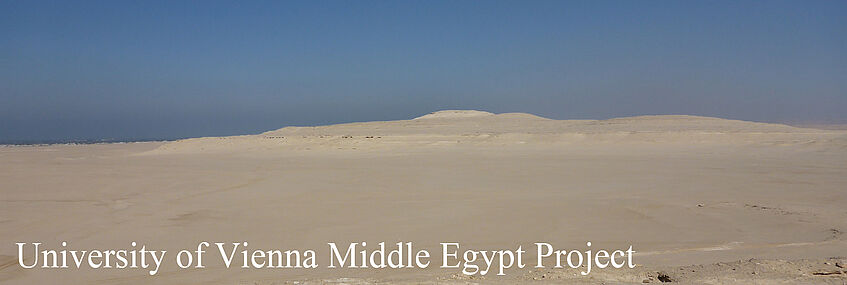The University of Vienna Middle Egypt Project

The University of Vienna Middle Egypt Project is an archaeological mission conducted by the Institute for Egyptology at the University of Vienna in cooperation with the Ministry of State of Antiquities in Egypt. It aims to investigate a little known area in the northern part of the governorate el-Minya. The mission focuses on two areas of interest on the east side of the Nile river, i.e. the Wadi el-Sheikh and nearby village of Nazlet Awlad el-Sheikh as well as the area between el-Sheikh Fadl and al-Qays. For decades and especially following the political events of 2011, large parts of this region have suffered from systematic looting and unchecked modern encroachment, which makes it necessary to salvage valuable information about this area’s archaeological remains before it is all lost. These range from evidence for ancient mining industries, cities and cemeteries.
The Institute for Egyptology aims to develop a long-term research strategy to investigate the archaeological sites and history of this region, and thereby contribute to preserving its ancient past through scientific surveys, documentation, conservation and rescue excavations.
For more details click here:
Acknowledgements
The University of Vienna mission greatly appreciates the cooperation with and support provided by the Ministry of State of Antiquities, Supreme Council of Antiquities in Egypt, the colleagues at the local antiquities inspectorate at el-Minya and the many members of the mission who have participated so far, especially: Ibrahim Abulhamdi, Bakri Badri, Serag Bakhid, Ulrich Friesenegger, Ahmed el-Laithy, Elizabeth Hart, Richard Jaeschke, Michael Klaunzer, Alexander Makovics, Abdel-Gabbar Mohamed, Claudia Singer and Thomas Stöllner. Photographs were taken by various mission members and in particular by the photographer Franz Stangelberger.
Select Bibliography
T. M. Barket and R.M. Yohe, 'A Technological Evaluation of the Flint Blade-Core Reduction Sequence at Wadi el-Sheikh, Middle Egypt', Lithic Technology, 36,1 (2011), 27-38.
E. Baumgartel, 'The Flint Quarries of Wadi el-Sheykh', Ancient Egypt (1930), 103-108.
F. Gomaa, Mittelägypten zwischen Samalut und dem Gabal Abu Sir, (Wiesbaden, 1991).
F. Gomaa, 'Särge und andere Funde aus der Nekropole der Falkenstadt', MDAIK 57 (2001), 35-57.
W. Kaiser, 'Bericht über eine archäologisch-geologische Felduntersuchung in Oberägypten und Mittelägypten', MDAIK 17 (1961), 39-40.
G. Negro and M. Cammelli, 'The flint quarries of Wadi El Sheikh (Eastern Desert of Egypt)', Sahara 21 (2010), 107-116.
A. Pawlik, 'The lithic industry of the Pharaonic site Kom el-Ahmar in Middle Egypt and its relationship to the flint mines of Wadi el-Scheikh', In: Stone Age – Mining Age, Der Anschnitt, Beiheft 19, (Bochum, 2005), 545-561.
H. Ranke, Koptische Friedhöfe bei Qarara, (Berlin/Leipzig, 1925).
H.W. Seton-Karr, 'Discovery of the lost flint mines of Egypt', in: Journal of the RoyalAnthopological Institute of Great Britain and Ireland 27 (1898), 90-92.
G. Weisgerber, 'Altägyptischer Hornsteinbergbau im Wadi el-Sheikh', Der Anschnitt 34 (1982), 186-210.
G. Weisgerber, 'The ancient chert mines at Wadi el-Sheikh (Egypt)'. In: G. de Sieveking and M.H. Newcomer, (eds.), The human uses of flint and chert. Proc. 4th International Flint Symposium, Brighton 1983, (Cambridge, 1987), 165-171.
